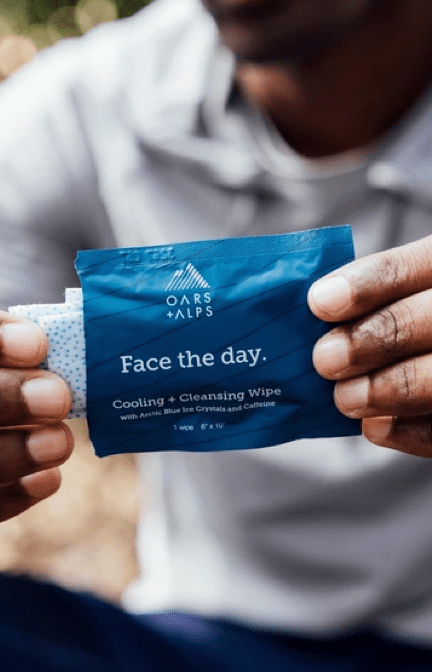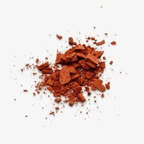Hair Care Ingredients

Hair Care Ingredients 101
Men have thicker hair strands and scalp skin than women, so of course they have unique hair care needs. When we began our hair care line, we started with the obvious pain points, like dryness, itching, and flakes. Turns out these are all symptoms caused or made worse by harsh chemicals found in many common brands. So we created our hair care line to address that. No more hair-stripping Sulfates, hormone-mimicking Parabens, or harmful Phthalates.
Except for nine prohibited ingredients, any raw material can be used as a cosmetic
ingredient—without FDA approval.
How Hair Care Ingredients Should Help Your Hair & Scalp
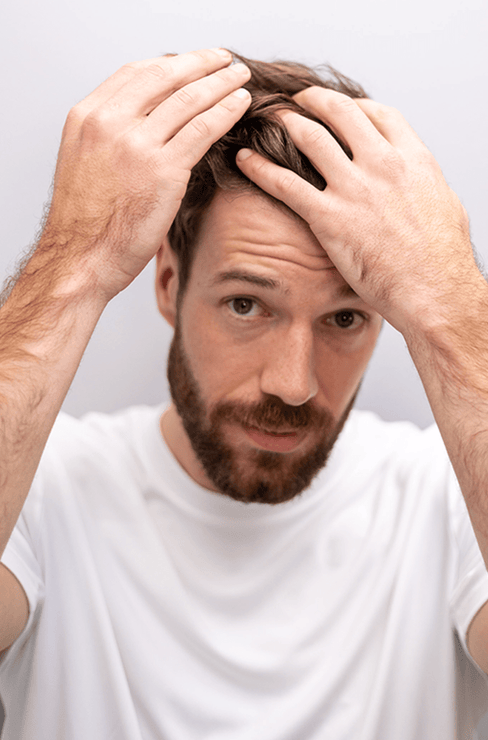
• Tea Tree Oil
• Witch Hazel Extract
• Apple Cider Vinegar
Balance Oil Levels
Men’s scalps naturally produce more oil than women's to nourish hair and keep it healthy. But too much built up oil looks greasy and dull. On the other hand, too much cleansing can strip away hair’s oil, leaving it dry and susceptible to breaking. Our hair care ingredients work together to give that just-right balance so your hair appears healthier and is easier to style.
What are oils in hair caused by?
The oil in your hair, called sebum, is secreted by millions of tiny sebaceous glands all over your body. These glands constantly produce oil throughout our lives to nourish our skin, including our scalp, and hair strands. They also act as the first line of defense, protecting skin from infection and pollution.
What are the best hair care ingredients for balancing oil levels?
Men with oily hair need specific ingredients that many traditional shampoos and conditioners can’t deliver. The best way to tame excess oils is to wash it away with other oils and astringents. Our Invigorating Shampoo uses Tea Tree Oil to emulsify sebum. Witch Hazel Extract and Apple Cider Vinegar help to break sebum up so it can be washed away.
Prevent Moisture Loss
When your hair is healthy and strong, it uses sebum to nourish and fortify itself. But many drugstore shampoos use harsh detergents to strip your hair of that natural oil. We use only gentle ingredients to clean your hair without robbing it of moisture or throwing off its pH levels.
What makes hair lose moisture?
Your hair loses moisture by being exposed to the sun and wind every day, especially when being active. As sweat dries, your hair’s moisture evaporates with it. Swimming in saltwater and chlorine also have a drying effect, as can too much blow drying, over-washing, and not enough conditioning.
Which hair care ingredients prevent moisture loss?
Guys can prevent moisture loss using a few different kinds of ingredients, like those found in our Hydrating Shampoo. Rich plant-based oils, like Coconut Oil, deeply nourish each strand. Sea Kelp and Alpine Caribou Moss™ offer vitamins and minerals that promote moisture retention. Glycerin adds an additional layer of moisture.

• Coconut Oil
• Sea Kelp
• Alpine Caribou Moss™
• Glycerin

• Creatine
• Olive Fruit Oil
• Grapeseed Oil
Strengthen Hair Strands
Your hair care products should do more than cleanse and style. They should strengthen hair from the core (called the medulla) to the outside of the strand (cuticle), as well as the middle (cortex).
What determines the strength of hair?
The strength of each hair fiber is determined by your age, genetics, hair color, moisture, as well as the grooming products you use. If you’ve bleached or treated your hair, that can also negatively affect your hair’s structure, as can extensive sun exposure or blow drying.
Which hair care ingredients offer the maximum strengthening?
Strong hair is less likely to break, which leaves you with a fuller head of hair. To provide as much strength as possible, we use ingredients that are proven to fortify your hair. We use Creatine, a derivative of amino acids, to help hair rebuild its structure and keep it smooth. Lightweight oils help keep hair supple and flexible.
Maintain Scalp Health
Your hair isn’t the only thing that needs nourishing. Men’s scalps play a big part in overall hair health too. So the ingredients in your hair products should support the skin underneath your hair too. This is especially important to guys who are bald or shave their heads if they want to eliminate flakes and unwanted shine.
How does scalp health affect hair?
Only a clean scalp will promote healthy cell turnover. Your hair care products should help remove dead skin cells from around the follicle base so it can grow to its fullest potential. They can also help avoid scalp conditions like dandruff, psoriasis, and dermatitis, which can lead to rough, brittle hair.
Which hair care ingredients help support scalp health?
Certain ingredients can help maximize your scalp health. We use Menthol to stimulate the scalp and fight dryness and itching. Tea Tree Oil and Apple Cider Vinegar help eliminate buildup on the scalp, promoting hair health. Alpine Caribou Moss™ helps keep scalp skin elastic and protects it from free radicals.
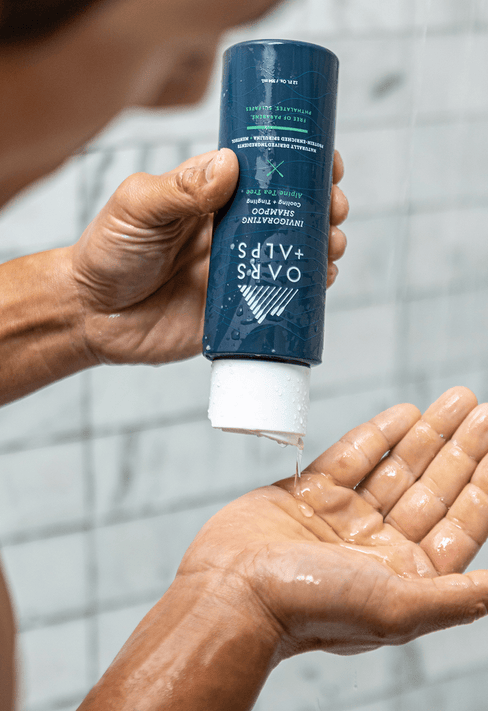
• Menthol
• Tea Tree Oil
• Apple Cider Vinegar
• Alpine Caribou Moss™
Our Powerful, Clean Ingredients
-
 Activated Charcoal
Activated CharcoalAbsorbs impurities up to
200x its weight and helps
prevent acne. Also
functions as an exfoliant. -
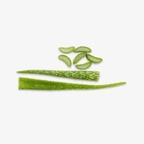 Aloe Vera
Aloe VeraSoothes and hydrates skin
without clogging pores. -
 Alpine Caribou Moss™
Alpine Caribou Moss™Reduces the effect of aging
and guards against pollution
and other stressors. Featured
in nearly all of our products. -
 Coconut-Derived Surfactants
Coconut-Derived SurfactantsBreak down oils and fats
without stripping the skin
of its natural moisture. -
 Corn Starch
Corn StarchWicks away moisture (i.e. sweat) and keeps your skin feeling smooth, dry and comfortable
-
 Jojoba Oil
Jojoba OilPrevents harmful, acne-causing bacteria growth. Softens dry and irritating spots and restores skin to a balanced condition.
-
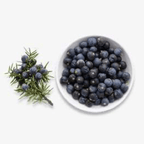 Juniper Berries
Juniper BerriesMildly buff away dead skin
cells and provide ultimate
cleanliness. -
 Safflower
SafflowerNon-irritating ingredient that prompts skin to retain moisture, while removing dirt and oil. Lends
skin a healthy glow and reduces the appearance of wrinkles. -
 Shea Butter
Shea ButterHelps tissue cell regeneration, softens skin and boosts collagen production. Penetrates deep into skin to moisturize and prevent windburn, sunburn and dry, cracked skin.
-
 Vitamin E
Vitamin EBlocks free radicals—a major factor in aging—from the body. Helps reduce appearance of wrinkles and keeps skin looking youthful.
-
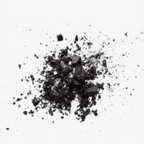 Volcanic Sand
Volcanic SandDeeply exfoliates skin while restoring skin vibrancy. Stimulates blood circulation.
-
 Blueberry Extract
Blueberry ExtractFilled with antioxidants that protect the skin from free radicals which contribute to signs of aging
Ingredients To Avoid In
Skincare Products
If you see these on the back of a label, try one of
our thoughtfully-formulated products instead.
-
Benzalkonium
ChlorideDisinfectant used as a preservative. Associated with severe skin, eye and respiratory irritation and allergies.
Typically found in: lipsticks, moisturizers,
diaper creams, and other cosmetics. -
Coal Tar
Byproduct of coal
processing that adds color
and prevents dandruff.
Known carcinogen.Typically found in: hair
dye, shampoo. -
Ethylenediaminetetraacetic
Acid (EDTA)Disinfectant used as a preservative. Associated with severe skin, eye and respiratory irritation and allergies.
Typically found in: lipsticks, moisturizers,
diaper creams, and other cosmetics. -
Ethanolamines
(MEA/DEA/TEA)Surfactants and pH adjusters.
Linked to allergies, skin toxicity,
hormone disruption and inhibited
fetal brain development.Typically found in: hair dyes, mascara,
foundation, fragrances, sunscreens, dry
cleaning solvents, paint, pharmaceuticals. -
Formaldehyde
Preservative in cosmetics—look for
quaternium-15, DMDM hydantoin, imidazolidinyl urea and several other preservatives. A known carcinogen that is also linked to asthma, neurotoxicity and developmental toxicity.Typically found in: shampoo,
body wash, bubble bath. -
Hydroquinone
Skin-lightening chemical
that inhibits the production
of melanin. Linked to
cancer, organ toxicity and
skin irritation.Typically found in: skin-
lightening creams. -
Methylisothiazolinone and
MethylchloroisothiazolinoneChemical preservatives.
Among the most common
irritants, sensitizers and
causes of contact skin
allergies.Typically found in: shampoo,
conditioner, body wash. -
Oxybenzone
Sunscreen agent and
ultraviolet light absorber.
Linked to irritation,
sensitization and allergies
and possible hormone disruption.Typically found in:
sunscreen, moisturizers. -
Parabens (methyl-, isobutyl-,
propyl- and others)Class of preservatives
commonly used to prevent the
growth of bacteria and mold.
Hormone disruptors, which
may alter important hormone
mechanisms in our bodies.Typically found in: synthetic fragrance, nail polish, hairspray, and plastic materials.
-
Phthalates (DBP, DEHP,
DEP and others)Class of plasticizing chemicals
used to make products more
pliable or to make fragrances
stick to skin. Believed to disrupt the endocrine system and may cause birth defects.Typically found in: synthetic fragrance, nail polish, hairspray, and plastic materials.
-
Retinyl Palmitate and
Retinol (Vitamin A)Nutrient that may damage
DNA and speed the growth of
skin tumors when used
topically.Typically found in: moisturizers, anti-aging skincare.
-
Sodium Lauryl Sulfate
and Sodium Laureth
Sulfate (SLS and SLES)Surfactants that can cause
skin irritation or trigger
allergies.Typically found in: shampoo, body wash, bubble bath.
-
Triclosan and
TriclocarbanAntimicrobial pesticides toxic
to the aquatic environment.
May also impact human
reproductive systems.Typically found in: lipsticks, moisturizers, diaper creams, and other cosmetics.
